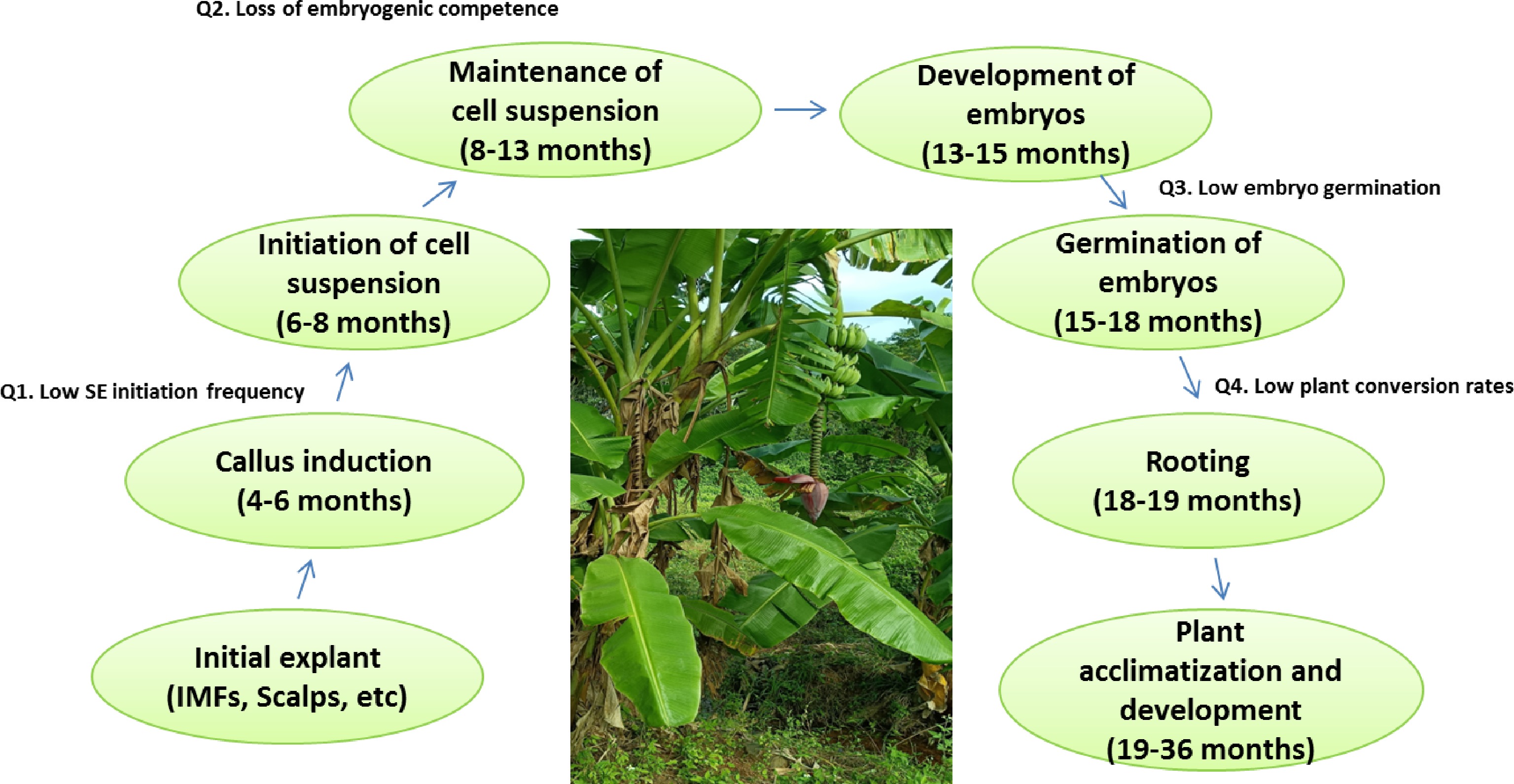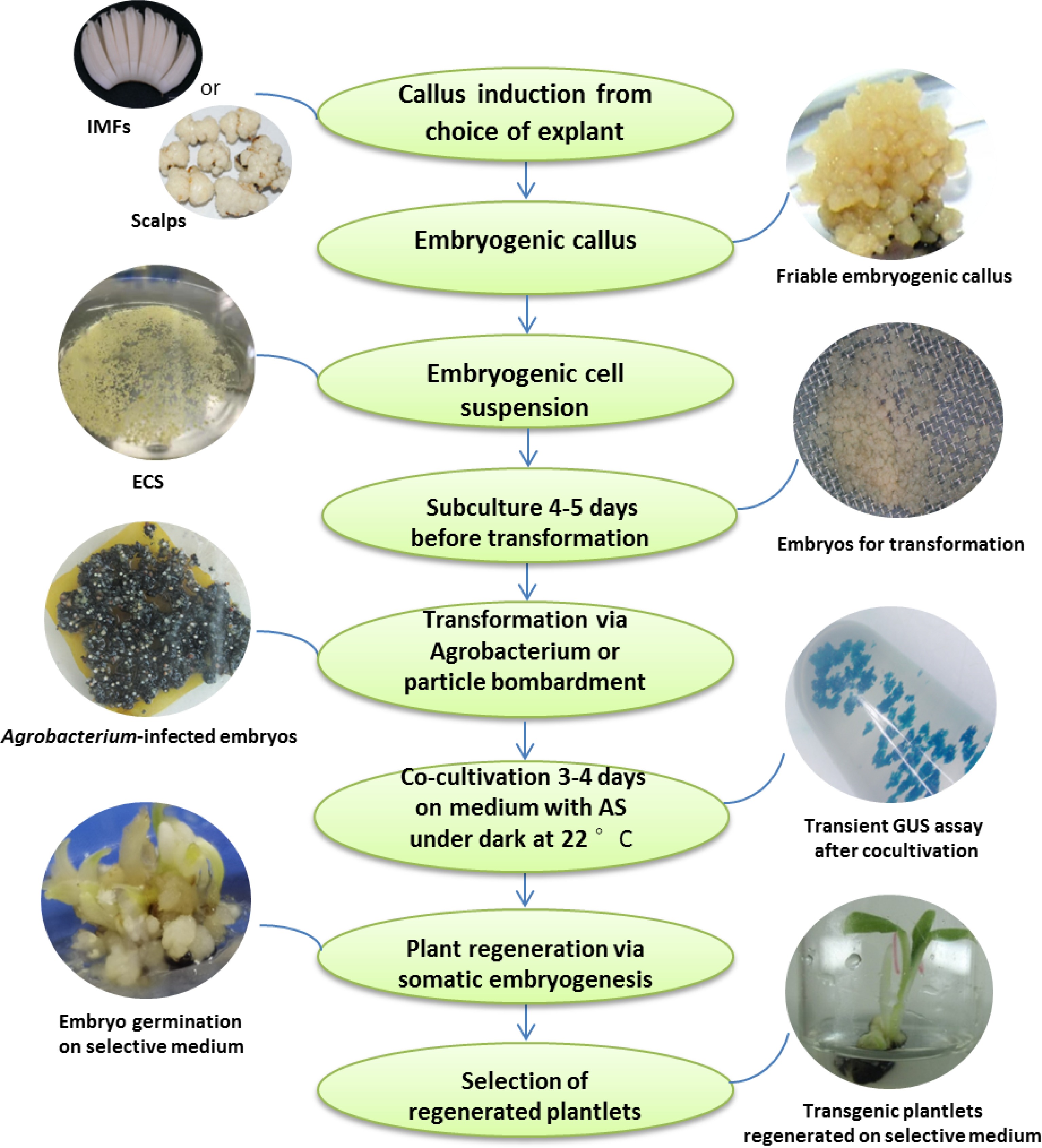-

Figure 1.
The main phases and time required for each phase in the somatic embryogenesis of banana and critical questions (Q). (SE) somatic embryo; (IMFs) immature male flowers.
-

Figure 2.
Schematic representation of genetic transformation steps of banana using embryogenic cell suspension. Scalps and immature male flowers (IMFs) are the most used explants to establish a renewable ECS for seedless banana cultivars. The photos of scalps and friable embryogenic callus are cited from Tripathi et al.[31].
-
Trait Gene Sources Transformation method Result Cultivar Reference Fungal Foc Race2 resistance MSI-99 Synthetic Agrobacterium/EHA105/ ECS Improved disease resistance against Foc and black leaf streak disease Rasthali (AAB) [67] Foc Race1 resistance β–1,3–endoglucanase Soybean Agrobacterium/LBA4404/Single buds Increased tolerance to Foc Race 1 Rasthali (AAB) [68] Bcl-xL, Ced-9, Bcl-2 3' UTR Animal Agrobacterium/LBA4404/ECS Apoptosis-inhibition-related genes confer resistance to Foc Race 1 Lady Finger (AAB) [69] PhDef1 and PhDef2 Petunia Agrobacterium/EHA105/ECS Improved fungal resistance with normal growth and no stunting phenotype Rasthali (AAB) [70] ihpRNA-VEL and ihpRNA-FTF1 Agrobacterium/EHA105/ECS Increased resistance to Foc Race 1 Rasthali (AAB) [71] MusaDAD1, MusaBAG1 and MusaBI1 Banana Agrobacterium/EHA105/ECS Increased resistance to Foc Race 1 Rasthali (AAB) [72] Sm-AMP-D1 Stellaria media Agrobacterium/EHA105/ECS Improved resistance against Foc Race 1 and no gross growth abnormalities Rasthali (AAB) [73] Ced9 Synthetic − Increased resistance against Fusarium wilt Sukali Ndiizi (AAB) [74] Ace-AMP1 Onion seeds Agrobacterium/LBA4404/ECS Enhanced resistance to Foc race 1 Rasthali (AAB) [75] Ace-AMP1 + Ca-pflp Allium cepa L; Capsicum annum L. Agrobacterium/AGL1/ ECS Stacked Ace-AMP1 and pflp transgenic plants showed resistance to Foc race 1 Rasthali (AAB) [76] Foc TR4 resistance Human lysozyme (HL) Agrobacterium/EHA105/corm slices Improved resistance to Foc TR4 Taijiao (AAA) [77] Pflp Sweet pepper Agrobacterium/EHA105/
multiple bud clumpsEnhanced resistance to Foc TR4 Pei Chiao (AAA) and Gros Michel (AAA) [78] TLP or PR-5 Rice Biolistics/Single
cauliflower-like bodiesEnhanced resistance to Foc TR4 Pisang Nangka (AAB) [79] ThChit42 Trichoderma harzianum Agrobacterium/EHA105/ECS Enhanced resistance to Foc TR4 Furenzhi (AA) [80] RGA2 or Ced9 Banana Agrobacterium/EHA105/ECS Improved promising resistance against Fusarium wilt Grand Nain (AAA) [81] MaPR-10 banana Agrobacterium/−/ECS Improved tolerance against Fusarium infection Berangan [82] MaLYK1 Banana Agrobacterium/EHA105/ECS Increased resistance to Foc TR4 Cavendish (AAA) [83] Synthesis of ergosterol (ERG6/11) − Agrobacterium/EHA105/ECS strong resistance to Fusarium wilt Brazil (AAA) [84] MpbHLH Banana Agrobacterium/EHA105/ECS Enhanced Foc TR4-resistance of Cavendish banana Brazil (AAA) [85] Sigatoka resistance ThEn-42 + StSy + Cu,Zn-SOD co-transformation Trichoderma harzianum
+ grape + tomatoBiolistics/ECS Enhanced tolerance to Sigatoka Grand Nain (AAA) [86] rcc2 or rcg3 Rice Agrobacterium/EHA105/ ECS Enhanced host plant resistance to black Sigatoka Gros Michel (AAA) [87] Bacterial BXW resistance Hrap Sweet pepper Agrobacterium/AGL1/ ECS About 20% of the Hrap lines showed
100% resistance for both mother and
ratoon crops under field conditionsSukali Ndiizi (AAB) and Mpologoma (AAA) [88, 89] Pflp Sweet pepper Agrobacterium/EHA105/ ECS About 16% of the Pflp lines showed
100% resistance for both mother and
ratoon crops under field conditionsSukali Ndiizi (AAB) and Nakinyika (AAA) [89, 90] Stacked Harp and Pflp Sweet pepper Agrobacterium/AGL1/ ECS Stacked Harp and Pflp transgenic plants
had higher resistance to X cmGonja manjaya (AAB) [91] Xa21 Rice Agrobacterium/EHA105/ ECS 50% of the transgenic lines showed complete resistance to X cm Gonja manjaya (AAB) [92] Viral Rep BBTV − Completely resistant to BBTV infection was found under glasshouse conditions Brazilian (AAA) [93] BBTV-G- cp BBTV Biolistics/apical meristem Williams (AAA) [94] Rep, ProRep BBTV − Rasthali (AAB) [95] Abiotic stress Salt, oxidative stress MusaWRKY71 banana Agrobacterium/EHA105/ ECS Enhanced tolerance towards oxidative and salt stress Rasthali (AAB) [96] Cold, drought, salt MusabZIP53 banana Agrobacterium/EHA105/ ECS Transgenic plants displayed severe growth retardation Rasthali (AAB) [97] Cold MpMYBS3 banana Agrobacterium/EHA105/ ECS The transgenic lines had higher cold tolerance Brazil (AAA) [98] Salt, drought MusaNAC042 banana Agrobacterium/EHA105/ ECS MusaNAC042 is positively associated with drought and salinity tolerance Rasthali (AAB) [99] Drought, salt Musa-DHN-1 banana Agrobacterium/-/ ECS Improved tolerance to drought and salt-stress Rasthali (AAB) [100] Salt, drought AhSIPR10 Arachis hypogaea Agrobacterium/EHA105/
multiple shoot clumpTransgenic plants showed better tolerance of salt and drought conditions Matti (AA) [101] Drought, salt, oxidative stress MusaSAP1 banana Agrobacterium/EHA105/ ECS Transgenic plants displayed better stress endurance characteristics Rasthali (AAB) [102] Cold, salt, drought MusaPIP1;2 banana Agrobacterium/EHA105/ ECS Transgenic plants showed better abiotic stress survival characteristics Rasthali (AAB) [103] Salt MusaPIP2;6 banana Agrobacterium/EHA105/ ECS Transgenic plants showed better tolerance under salt stress Rasthali (AAB) [104] Salt, drought MaPIP1;1 banana Agrobacterium/EHA105/
thin cell layers from shoot tipsImproved tolerance to salt and drought stresses Brazilian (AAA) [105, 106] Drought, cold ,salt MaPIP2-7 banana Agrobacterium/EHA105/
thin cell layers from shoot tipsImproved tolerance to salt, drought, and cold stresses Brazilian (AAA) [107] MaSIP2-1 banana Agrobacterium/EHA105/
thin cell layers from shoot tipsTransgenic plants had a stronger drought and cold tolerance than the control Brazilian (AAA) [108] Salt, drought AhcAPX Arachis hypogea Agrobacterium/EHA105/
multiple shoot clumpEnhanced the tolerance to drought and salt stress Grand naine (AAA) [109] Fruit quality and others Biofortified Iron ferritin soybean Agrobacterium/EHA105/ ECS A 6.32-fold increase in iron accumulation and a 4.58-fold increase in the zinc levels were noted in the leaves of transgenic plants Rasthali (AAB) [110] Biofortified pro-vitamin A MtPsy2a banaan Agrobacterium/AGL1/ ECS A high content of β-CE (75.1 µg/g dw) was found in the fourth generation with no variation in critical agronomical features such as yield and cycle time Dwarf Cavendish (AAA) [111] Fruit ripening MaMADS1 and MaMADS2 banana Agrobacterium/-/ ECS Repression of either MaMADS1 or
MaMADS2, resulted in delayed ethylene
synthesis and maturationGrand Nain (AAA) [112] Sense and anti-sense MaMADS36 banana Agrobacterium/GV3101/
thin cell layers from shoot tipsMaMADS36 represents a central molecular switch in regulating banana fruit ripening Red banana (AAA) [113] Foc, Fusarium oxysporum f. sp. cubense; ECS, embryogenic cell suspension; BBTV, Banana bunchy top virus; NM, not mention. Table 1.
Genetic transformations of banana (Musa spp.).
-
Cultivar Explant Strategy of transformation Cas9 promoter sgRNA promoter Target gene Target trait Result Editing efficiency Reference Baxi; AAA ECS Agrobacterium-mediated transformation
EHA105Ubi OsU6a MaPDS Albino and variegated phenotype Murtation in target genes; Albino phenotype in transgenic plants 55% [118] Rasthali; AAB ECS Agrobacterium-mediated transformation
Agl12 × CaMV35S OsU3 MaPDS Albino and variegated phenotype Murtation in target genes; Albino phenotype in transgenic plants 59% [119] Williams; AAA ECS Agrobacterium-mediated transformation
EHA105Ubi;CaMV35s OsU3 MaPDS Albino and dwarf phenotype Murtation in target genes; Albino and dwarfing phenotype in transgenic plants 63% [120] Sukali Ndiizi; AAB;Gonja Manjaya; AAB ECS Agrobacterium-mediated transformation
EHA1052 × CaMV35S OsU6 MaPDS albino and variegated phenotypes Generation of mutants with albino and variegated phenotypes 100% [121] Williams; AAA ECS Agrobacterium-mediated transformation NM NM MaCHAOS Pale-green phenotypes Murtation in target genes; Pale-green phenotypes and normal growth NM [122] Baxi; AAA protoplast PEG-mediated transformation Ubi OsU3 MaPDS - The efficiency of CRISPR/Cas9-mediated mutagenesis was higher than that of CRISPR/Cas12a, and RNP-CRISPR-Cas9 1.04% (Cas9), 0.92% (RNP), 0.39% (Cas12a) [61] Brazilian; AAA protoplast PEG-mediated transformation Ubi MaU6 MaPDS - Increased mutation efficiency of CRISPR/Cas9 genome editing in banana by optimized construct 4-fold [123] Gonja Manjaya; AAB ECS Agrobacterium-mediated transformation
EHA105Ubi OsU6 Viral genes Banana streak virus (BSV) Inactivation of endogenous banana streak virus (eBSV) intergated in host genome and generated resistant banana plants against eBSV 95% [124] Sukali Ndiizi; AAB ECS Agrobacterium-mediated transformation
EHA1052 × CaMV35S OsU6 MusaDMR6 Banana Xanthomonas wilt (BXW) Improved resistance to BXW disease in mutants with normal growth 100% [125] Grand Naine; AAA ECS Agrobacterium-mediated transformation
Agl1CaMV35S OsU3 MaLCYε Regulation synthesis of β-carotene Improved nutritional trait in transgenic plants with normal growth NM [127] Rasthali; AAB protoplasts and ECS electroporation-mediated transformation;
particle bombardment methodCaMV35S OsU3 MaCCD4 Regulatory mechanism of β-carotene homeostasis CCD4 negatively regulates β-carotene biosynthesis NM [128] Brazilian; AAA ECS Agrobacterium-mediated transformation Ubi OsU6a MaACO1 Shelf life More vitamin C and improved shelf life in transgenic plants 98% [129] Gros Michel; AAA ECS Agrobacterium-mediated transformation Ubi OsU6a/
OsU3MaGA20ox2 Semi-dwarf phenotype A lower active GA content and a semi-dwarf phenotype in transgenic plants NM [130] NM, not mentioned. Table 2.
Application of CRISPR/Cas9 gene editing technology in Musa.
Figures
(2)
Tables
(2)